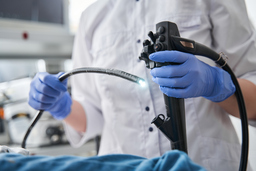Self-Biased Mass-Loaded Magnetoelastic Resonators, Encapsulation Approaches, and Interrogation Methods in Intraluminal Prosthes…
TECHNOLOGY NUMBER: 2018-350

OVERVIEW
Integration of a magnetoelastic sensor into the internal lumen of a stent- Generates signals that can be measured with an external coil
- Measures bile sludge accumulates to predict stent blockage
BACKGROUND
A stent is a small flexible plastic or metal tube that is used to prop open a constricted vessel or duct. Stents can be placed in the bile duct during a procedure known as endoscopic retrograde cholangio pancreatography (ERCP). While stents relieve symptoms caused by bile duct blockage, they accumulate tissue or biomass over time and eventually become blocked, commonly within three months after placement. Existing practices for monitoring stent blockage include blood tests, magnetic resonance imaging, or angiography, though these measures are imperfect and expensive. Shortcomings caused by these studies can lead to a preemptive and unnecessary invasive procedure to replace the stent before it is required, or they may alternatively lead patients to suffer significant symptoms before the need for stent replacement can be ascertained. Therefore, the need exists for a means by which to better assess the patency of stents in bile ducts.
INNOVATION
Researchers at the University of Michigan have integrated a magnetoelastic sensor into the internal lumen of a stent to further improve upon a direct wireless monitoring system they previously invented. The sensor is caused to mechanically vibrate via the application of an oscillating magnetic field from a coil external to the patient, generating an oscillating magnetic flux that can be measured with an external coil. The frequency response is sensitive to bile sludge accumulation and the stent blockage as the pathology progresses. Because the method is direct and wireless, it can alter the course of therapy at an earlier junction and prevent complications caused by stent occlusion. The innovation addresses the challenges facing this type of monitoring system, including miniaturization of the resonator and sensor elements, encapsulation of the device, and enhancement of the signal strength. The package material is biocompatible, chemically inert at body temperature, and electromagnetically transparent. It can be inexpensively fabricated to specific and reproducible sizes. And the package passes through the endoscope during delivery without impeding stent placement, permitting its use for various interventions.
-
expand_more mode_edit Inventor (6)Grace EltaJiqing JiangRamprasad Mohanan NambisanRichard KwonScott GreenYogesh Gianchandani
-
expand_more cloud_download Supporting documents (1)Product brochureSelf-Biased Mass-Loaded Magnetoelastic Resonators, Encapsulation Approaches, and Interrogation Methods in Intraluminal Prosthes….pdf